How Much Water To Use In Pressure Canner
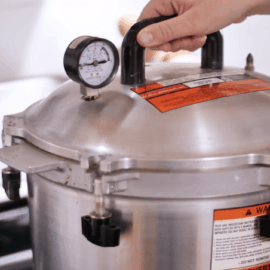
Pressure level CANNING.
It's the #1 thing that strikes fear into the middle of new homesteaders…
Stories of Neat Aunt Wanda blowing upward her kitchen with a pressure canner grow… which has resulted in a whole lot of us who are slightly petrified at the thought of using a hissing, pressurizing "bomb" to preserve food in our kitchens.
And it'due south understandable– if used incorrectly, pressure canners can indeed malfunction. And the results are often…. um… explosive.
BUT. Before you close out of this post and swear to never touch a pressure canner as long as y'all live, hear me out…
Because not just is pressure canning far safer than yous've likely been led to believe, there are a bunch of benefits that make information technology a skill well-worth learning.
(And if it makes you experience whatever better, I've been pressure canning for 9 years with a grand total of Zip explosions…)
(If you lot are new to any sort of canning at all, and then you'll definitely want to check out the How to Can tutorial– consummate with tons of pictures. You can as well bank check out my super awesome Canning Fabricated Easy course and ebook.)
Is Pressure level Canning Really Safe?
Yep! I am here to reassure y'all that, with a few precautions, force per unit area canning is absolutely nothing to worry about! Today's pressure canners have two, if not iii, safety valves. This mode, if the primary vent ever somehow gets plugged, at that place'due south all the same another road for the pressure to escape safely.
Why Bother with a Pressure Canner?
Water bath canning or boiling-h2o processing works keen for high-acid foods similar well-nigh fruits, jams, tomatoes, or pickles. The theory is that the acid helps to preserve the foods and prevent spoilage at the lower temps produced by the humid h2o.
All the same, for low-acid foods (recall beets, green beans, meats, potatoes), it is crucial that you use a force per unit area canner, since it reaches much higher temperatures and therefore preserves the nutrient safely without the added "insurance" of the acid. (And nope. You can't skip this step and just employ a h2o bath canner instead. If you do, y'all run the risk of botulism in your canned foods, which is the deadliest class of nutrient poisoning.)
Why I Honey Pressure Canning:
i. More Freezer Space
I usually freeze a lot of my garden produce, every bit well as many make-alee meal components. Combine that with our home-raised beef, I'm always running out of freezer space– even with my extra chest freezer.
I also beloved having a food supply that isn't dependent on the filigree– in the case of an emergency power outage, most of my frozen food would be a loss.
2. Homemade "Convenience" Foods.
The thought of beingness able to have ready-to-go, wholesome food at my disposal that doesn't require defrosting or freezer infinite is pretty much magical.
With my pressure canner, I can preserve chunks of beef, pinto or navy beans, and chicken or beef broth to be stored at room temperature– not to mention pre-fabricated suppers similar homemade beef stew and chili.
Types of Pressure level Canners
There are three primary kinds of pressure canners available on the marketplace today:
ane. Dial Gauge Canners
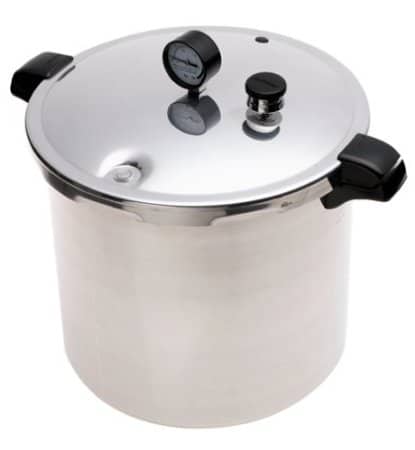 (This Presto canner is a punch gauge canner.)
(This Presto canner is a punch gauge canner.)
These canners have a dial pressure approximate on top of the lid to tell you when the force per unit area has reached the appropriate level. The dial approximate must be checked every year by the manufacturer or your local County Extension Role to make sure the reading is accurate. Otherwise, y'all adventure processing your foods at also-low force per unit area (can crusade spoilage or botulism) or too-loftier pressure (aka:possible explosions…)
2. Weighted Gauge Canners
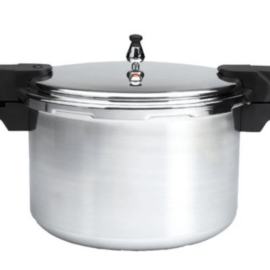
(This Mirro brand canner is an example of a weighted judge canner)
These canners don't accept gauges, but instead have removable, weighted regulators that are used to determine pressure. You lot can suit the pressure in the canner by added more or less weights to the lid.
3. Combo Judge Canner
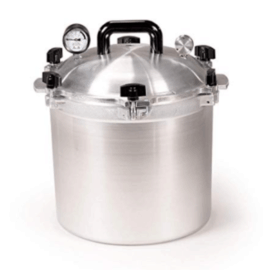 (All-American brand canners are philharmonic-estimate canners)
(All-American brand canners are philharmonic-estimate canners)
These canners non just have a dial gauge on top of the lid, they likewise take a removable, weighted regulator likewise. This regulator weight normally has three settings: five, 10, and fifteen pounds. The weight is what you use to determine pressure– the dial is just a dorsum-up in this instance.
 (Shut up of the weighted gauge from my All-American. Notice the iii settings of pressure: v, 10, and 15 pounds)
(Shut up of the weighted gauge from my All-American. Notice the iii settings of pressure: v, 10, and 15 pounds)
The Best Force per unit area Canner
Naturally, there's debate on this topic, only I personally adopt All-American pressure level canners and have used one exclusively for 9 years.
Here's why:
- After reading many user reviews of the All-American canner on Amazon, I found that in that location were very few unsatisfied customers. This trend stayed the same with my followers on Facebook, likewise as anyone else I take talked to.
- The All-American canner has no rubber gasket– that ways in that location is one less matter to maintain and supercede.
- All-American canners have weighted gauges– I definitely prefer that over the dial approximate, since I won't have to take information technology to be checked for accuracy every single year.
- They are made in the USA.
- They have half-dozen bolts to securely concur the hat.
- Although this is non the cheapest pressure level canner on the market, I don't heed paying a little extra for something I know that will last for years and years. As some of my readers mentioned, this is something you could definitely laissez passer down to your children and grandchildren. It'south a quality slice of equipment. I've had my canner for 9 years and it looks as good as the twenty-four hours I pulled it out of the box.
- I have the 21 1/ii quart Canner (Model 921).The 921 model will concord 19 pints or 7 quarts. This isn't their biggest model, but vii quarts is what my water bath canner holds, and I'g comfortable with that size.
(Please note- I am not affliated with All-American in whatever style. I just like 'em…)
Parts of a Pressure Canner
In this post, I'll be focusing on combo-guess canners, since that's what I accept.
Naturally, all manufacturers will be slightly different, so it'due south very important to read the instruction transmission for your particular canner. Fortunately, the majority of the parts will usually exist the same.
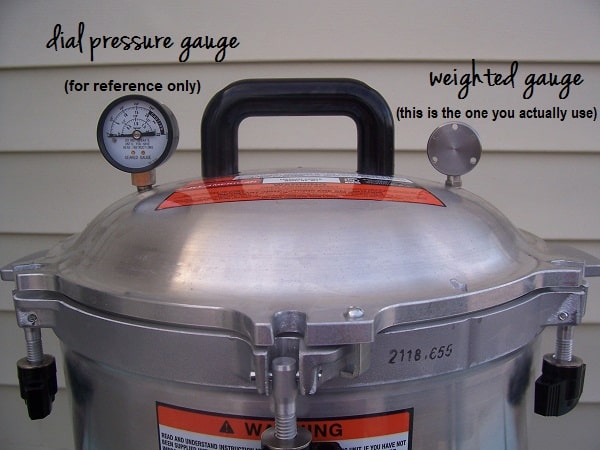
There are two gauges on the All-American canner: a dial gauge and a weighted gauge.
The weighted gauge sits on summit of the vent pipe.
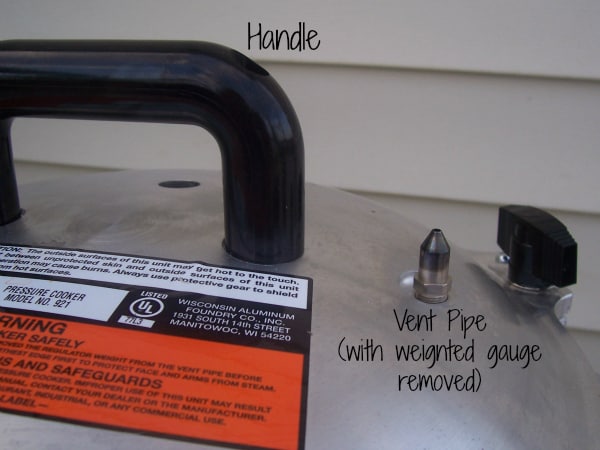
Many pressure canners have a safe gasket that fits between the lid and bottom, simply All-American canners like mine do not.
Instead, my canner has a metal-to-metal seal. I prefer this since safety gaskets are subject to bully and breaking and have to be replaced. The only maintenance that the metal-to-metal seal requires is a light oiling (use olive oil) every 2-3 uses.
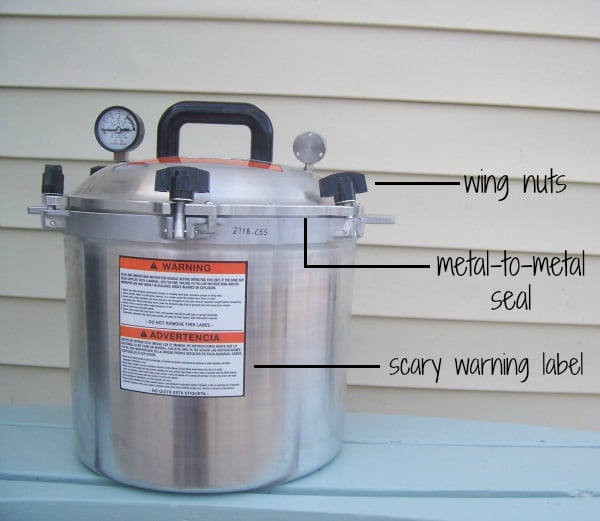
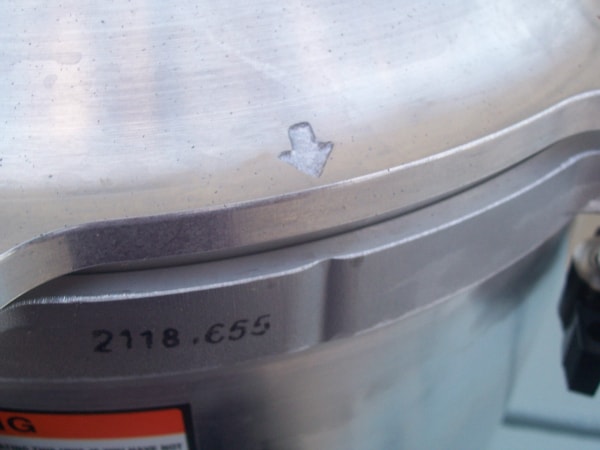
When you identify the lid on the base, exist sure that it is properly lined up. My model has a small pointer on the lid, and a groove on the rim of the base to bear witness you the proper alignment. (I retrieve some models have 2 arrows, merely it doesn't really matter.)
Another feature I like about my All-American is the added security of thehalf dozen fly nuts that fasten the lid onto the base.
It's very important that you tighten two opposite wing nuts at the aforementioned time when you go to adhere the lid to the base of operations. If you simply tighten one at a time, the hat can go unevenly attached to the base. This can event in loss of pressure and an unsuccessful canning adventure.
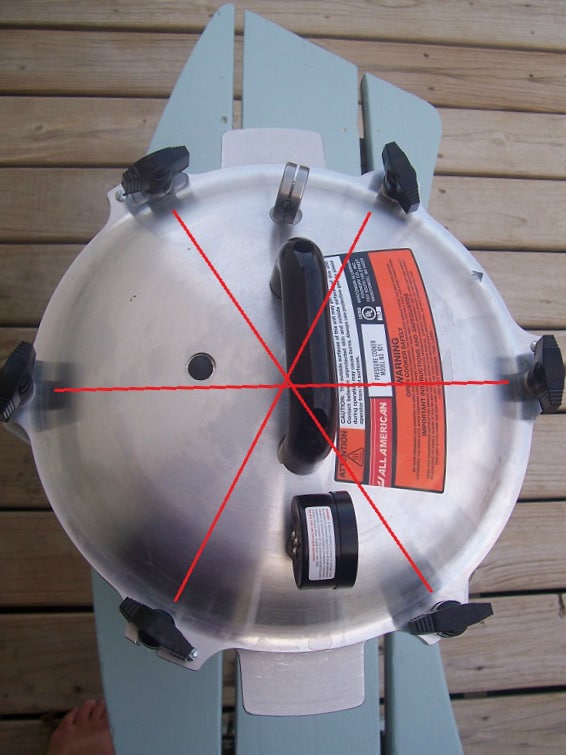
I drew some diagonal lines on this photo to aid illustrate the whole "diagonal tightening" concept.
Oh, and that little blackness rubber dot you see to the left of the handle? That's the overpressure plug. There's non much you lot need to know about that, other than it's an added condom feature *just in case* the pressure in the canner ever becomes besides high. (If that happens, it will popular out).
Merely make sure it's non worn or croaky, and clean it if it ever gets a build upward of food or grease.
The inside of the canner is pretty boring– information technology'due south just a big ol' aluminum pot.
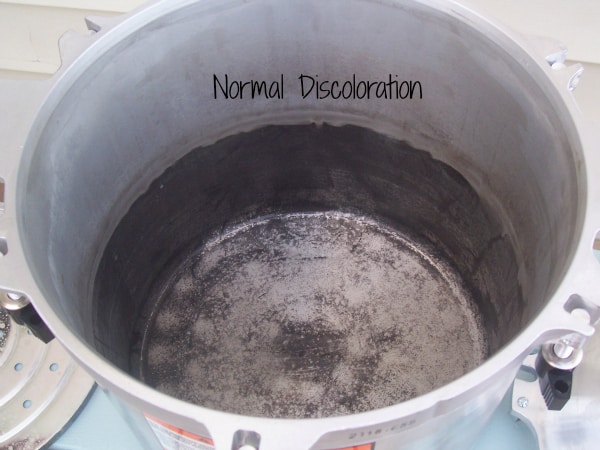
Mine discolored similar this the very first fourth dimension I used it, and that'due south normal. (The photo makes it await crusty, but it's not. The surface is yet smooth, merely "seasoned"…)
Now, the pot can become "pitted" if non probably cared for, so y'all practise want to make certain that youthoroughly launder and dry it later every utilize.
My canner came with 2 racks. 1 always goes on the lesser (never place jars directly on the bottom of the canner itself) and 1 goes in the centre if yous are stacking pint jars.
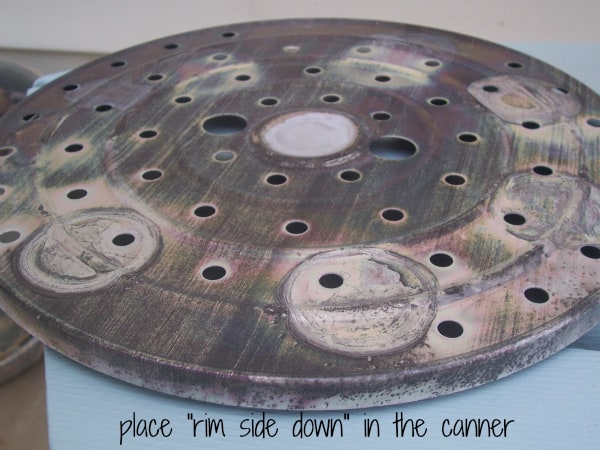
Simply place the rack with the rim facing downwardly before adding any jars to your canner.
Pressure Canner Directions:
Note: I won't be covering the bones techniques of safely putting the nutrient into the jars in this mail. Bank check out my In-Depth Canning Tutorial for all that info (or my Canning Made Easy Course).
(This tutorial will cover how to utilize a weighted gauge All-American Pressure level Canner. However, almost other canners will follow a similiar technique.)
1. Brand sure the canning jars are clean and hot.
This can be accomplished by placing them in a pot of hot water, allowing them to sit in a sinkful of hot water, or by running them through a quick bike in the dishwasher. One of the cracking parts of pressure canning is that y'all don't have to sterilize the jars like you practise with a water bath canner. The high oestrus of the pressure canning process takes care of that. However, you do want to oestrus them up to prevent breaking and bang-up when you lot place the hot food within.
ii. Fill the canner with 2-3 inches of water and set it on the burner.
It is VITAL that you do Non run out of water during the canning process, every bit it can seriously harm the canner. All the same, dissimilar the water bathroom canning method, you do not accept to completely cover the jars with h2o.
3. Place a rack in the bottom of the canner.
If you have a rack similar I exercise, be certain to place it rim-side downward. So, place your filled and sealed canning jars on top of that. If you are using pint jars, you can stack them in your canner with the second rack in betwixt the two layers. Depending on what you are canning and the recipe, you'll probably have hot jars with hot contents, so employ your handy-dandy jar tongs if you accept them.
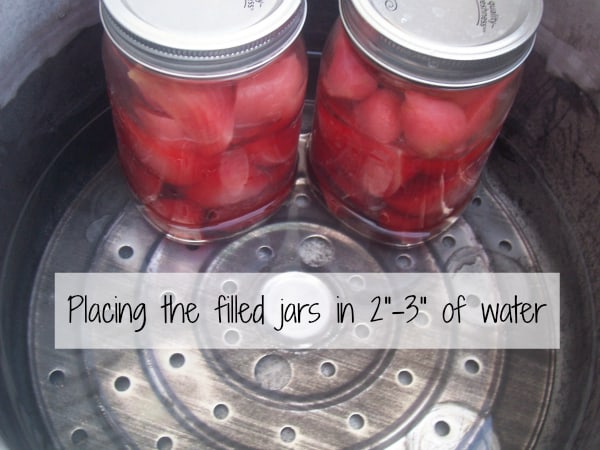
4. Place the lid on the canner.
My All-American canner has half dozen wing nuts that I must tighten in society to create a proper seal (ever tighten ii opposite wing basics at the aforementioned time). Nonetheless, unlike canner brands will have a variety of shut mechanisms.
v. Outset heating the canner.
Turn the stove burner on high heat.Make certain that your weighted gauge is NOT on the lid of the canner at this point.

6. Once the pressure vent starts releasing steam, set your timer for x minutes.
Allow the canner to "exhaust" for a total 10 minutes before yous practise anything else. You'll know when the steam starts to escape, because it will brainstorm to sputter and hiss and usually some water droplets will appear on the outside. This venting period is a good time to take a deep jiff and make clean upwards the kitchen a bit.
vii. Check your canning recipe for two numbers:
- First, you demand to look for how many pounds of pressure that the particular nutrient needs to exist processed at. Commonly, the recipe volition specify between v, x, and 15 pounds. (These are the 3 settings on your weighted gauge.) If you are at a high altitude similar me, (over 6,000 feet…) yous volition demand to suit accordingly. My All-American manual recommends that, regardless of what the recipe says, always use fifteen pounds of pressure level when processing foods at 2,000+ anxiety in a higher place body of water level.
- Secondly, expect for how long you need to process that detail food. My beets took thirty minutes, while things like meat or stew will ordinarily require over an hour of processing time.
eight. Identify the weighted gauge at the proper setting over the top of the pressure level vent.
Once the venting period is consummate, utilise a oven mitt to place the weighted gauge on the canner. Be careful— that steam is hot!
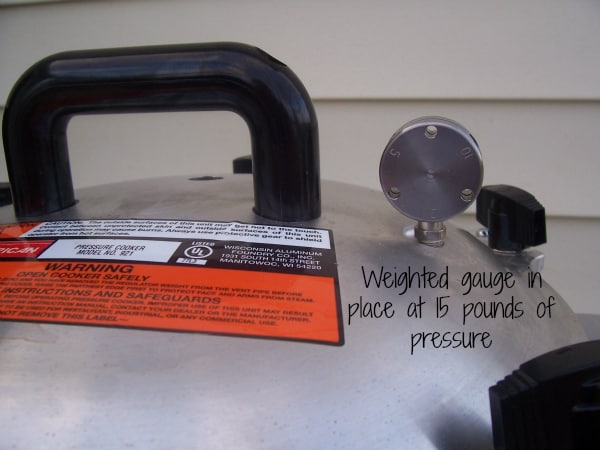
ix. Await for the force per unit area to build in the canner.
This is where the dial approximate comes in handy– you can watch the pressure slowly build and know when y'all're getting close.
10. Count the Jiggles.
In one case the canner reaches the proper pressure (15 pounds in my example), the weighted gauge volition begin to jiggle and rattle. This is when yous set your timer for the bodily nutrient processing time.
Now comes the part of the process that takes a little practise, but it's not hard. You want to hear a jiggle from the weighted gauge around 1-4 times per minute. This tells you that the pressure is staying at the right level. You Exercise NOT want the estimate to constantly jiggle through-out the timed period– this would indicate that the pressure in the canner is besides loftier.
I commonly cease upwardly standing by the stove for a while and counting.
As well many jiggles? Reduce the heat.
Non enough jiggles? Increase the rut.
I've establish that if I keep my burner at depression, it'south just about perfect. (I accept a gas stove that burns pretty hot…)
Once you get your jiggles regulated, you don't have to stand in that location and stare at the canner the entire fourth dimension. Feel gratuitous to clean upwards the kitchen or check your electronic mail, or whatever. Just try non to get out the canner completely unattended. (i.east. don't get outside to the barn and forget that y'all are canning!)
11. When the processing fourth dimension is complete, turn off the burner.
Do not move the canner– just allow information technology to cool down on its ain. (This will take a while.) Now information technology's safe to run outside to do barn chores or whatever else yous may need to practice.
12. Once the dial gauge reads cipher, it's safe to slowly remove the weighted gauge.
Utilise your oven mitt once again, equally it's still usually pretty hot. As long as the pressure in the canner is at zero and the weighted gauge is removed, y'all are rubber to remove the chapeau. Just make sure to crack it away from your face so you don't terminate up with a nasty steam burn.
13. Remove the jars of food.
Allow them to cool completely earlier checking their seals or placing them into the pantry. But similar water bath canning, you'll usually hear the "pop!" of the sealing lids adequately quickly.
14. Subsequently the canner cools completely, give information technology a gentle wash and dry thoroughly.
If you haven't oiled it in a while, apply a sparse film of olive oil to the metal-to-metal seal.
Can You Pressure Can in an Instant Pot?
No, please don't! I love my Instant Pot for lots of things, just canning isn't one of them!
Instant Pots or other pressure level cookers are very different than pressure canners. You cannot regulate the pressure level/temperature accurately enough and therefore they are dangerous to use for canning.
Where to Observe Pressure level Canning Recipes?
Information technology'south extremely important to use tested, approved recipes any time you can to ensure the food is free from dangerous leaner and spoilage.
The Ball Blue Book is ane of my favorite resources, as is the National Center for Home Food Preservation.
Hither are a few of my personal favorites:
- How to Pressure level Tin can Meat
- How to Can Beefiness Stew
- How to Tin Broth or Stock
- How to Can Pinto or Navy Beans
- How to Can Chili Peppers
Listen to the Old Fashioned On Purpose podcast episode #12 on the topic Five Canning Mistakes You Can't Beget To Brand HERE.
Can You lot Come Teach Me How to Can?
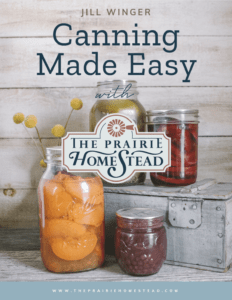
I wish! However, since flying all over the country teaching canning classes isn't going to fit into my schedule this time of twelvemonth, I have the next all-time thing!
I've created a very simple canning eBook that volition tell you EVERYTHING you need to know to go started canning on your homestead. It covers equipment, safety, water bath canning, pressure canning, and everything in between.
Get Started Canning Today!
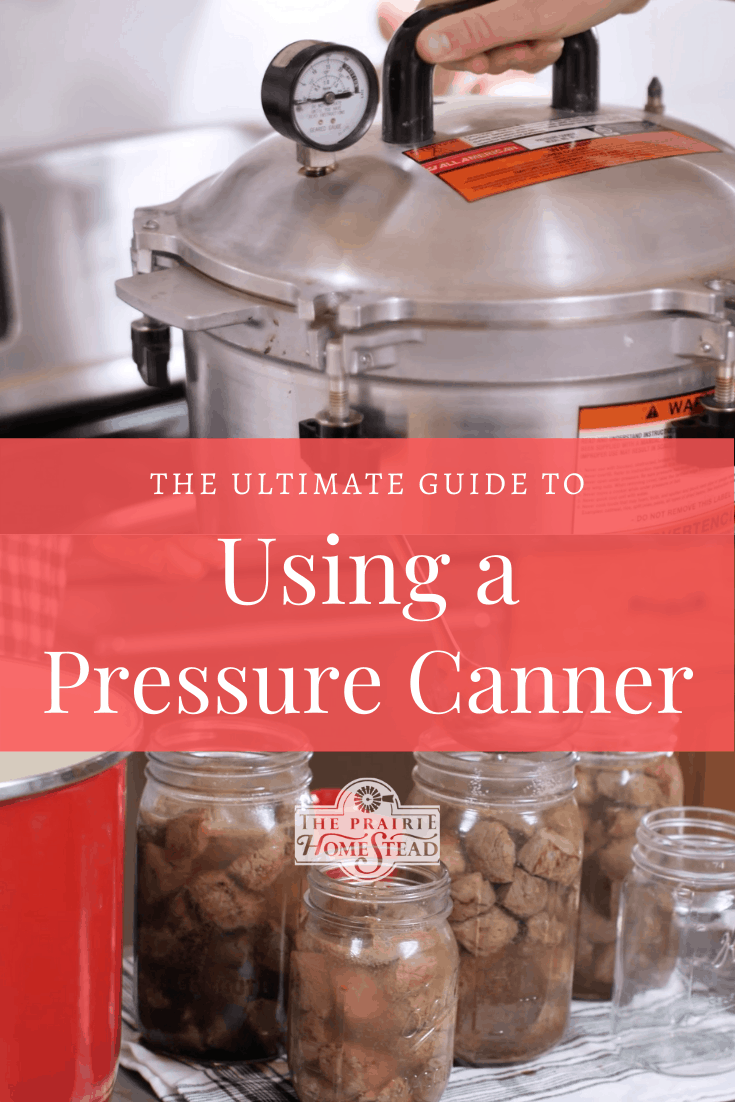
How Much Water To Use In Pressure Canner,
Source: https://www.theprairiehomestead.com/2012/08/how-to-use-a-pressure-canner-part-1.html
Posted by: owenscrind1984.blogspot.com


0 Response to "How Much Water To Use In Pressure Canner"
Post a Comment